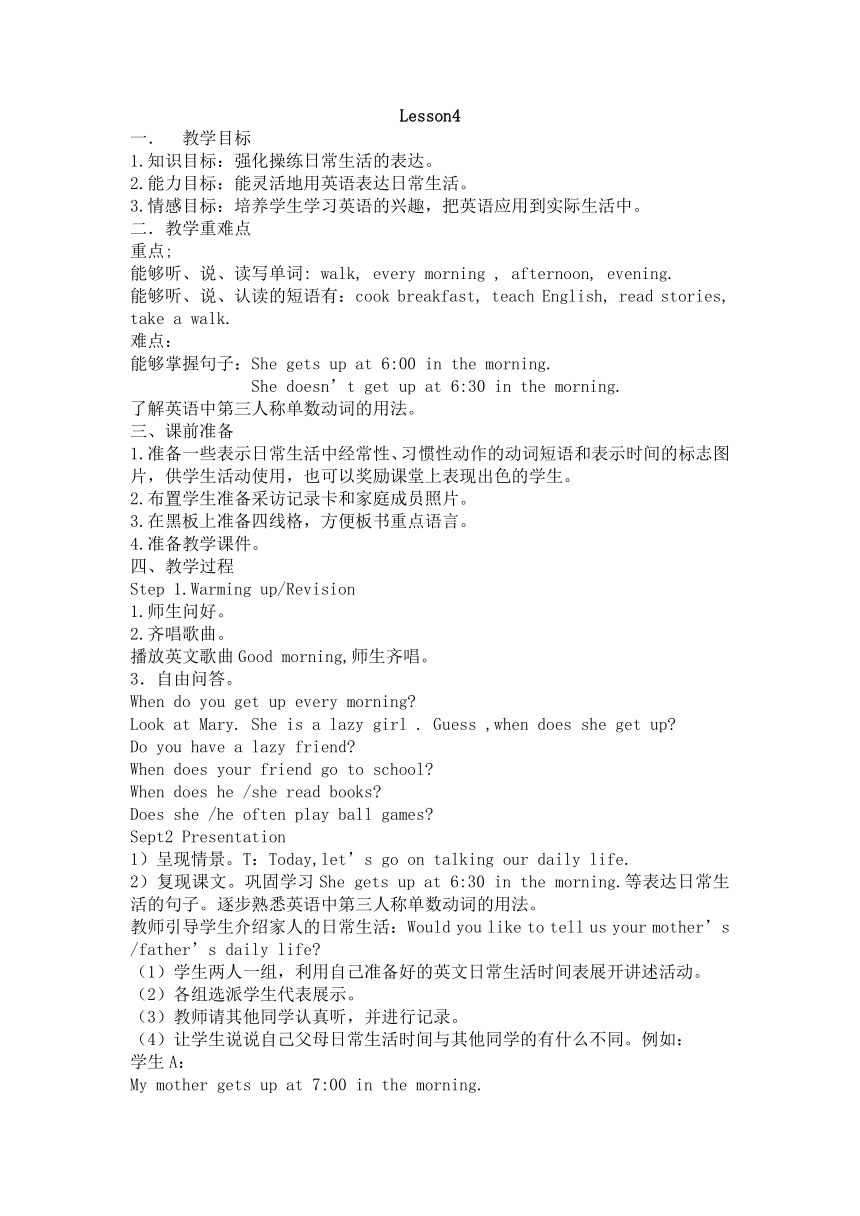Unit 1 I go to school at 8;00 Lesson 4 教案
文档属性
| 名称 | Unit 1 I go to school at 8;00 Lesson 4 教案 |

|
|
| 格式 | zip | ||
| 文件大小 | 118.1KB | ||
| 资源类型 | 教案 | ||
| 版本资源 | 人教精通版(三年级起点) | ||
| 科目 | 英语 | ||
| 更新时间 | 2017-03-29 10:14:54 | ||
图片预览

文档简介
Lesson4
教学目标
1.知识目标:强化操练日常生活的表达。
2.能力目标:能灵活地用英语表达日常生活。
3.情感目标:培养学生学习英语的兴趣,把英语应用到实际生活中。
二.教学重难点
重点;
能够听、说、读写单词:
walk,
every
morning
,
afternoon,
evening.
能够听、说、认读的短语有:cook
breakfast,
teach
English,
read
stories,
take
a
walk.
难点:
能够掌握句子:She
gets
up
at
6:00
in
the
morning.
She
doesn’t
get
up
at
6:30
in
the
morning.
了解英语中第三人称单数动词的用法。
三、课前准备
1.准备一些表示日常生活中经常性、习惯性动作的动词短语和表示时间的标志图片,供学生活动使用,也可以奖励课堂上表现出色的学生。
2.布置学生准备采访记录卡和家庭成员照片。
3.在黑板上准备四线格,方便板书重点语言。
4.准备教学课件。
教学过程
Step
1.Warming
up/Revision
1.师生问好。
2.齐唱歌曲。
播放英文歌曲Good
morning,师生齐唱。
3.自由问答。
When
do
you
get
up
every
morning
Look
at
Mary.
She
is
a
lazy
girl
.
Guess
,when
does
she
get
up
Do
you
have
a
lazy
friend
When
does
your
friend
go
to
school
When
does
he
/she
read
books
Does
she
/he
often
play
ball
games
Sept2
Presentation
1)呈现情景。T:Today,let’s
go
on
talking
our
daily
life.
2)复现课文。巩固学习She
gets
up
at
6:30
in
the
morning.等表达日常生活的句子。逐步熟悉英语中第三人称单数动词的用法。
教师引导学生介绍家人的日常生活:Would
you
like
to
tell
us
your
mother’s
/father’s
daily
life
(1)学生两人一组,利用自己准备好的英文日常生活时间表展开讲述活动。
(2)各组选派学生代表展示。
(3)教师请其他同学认真听,并进行记录。
(4)让学生说说自己父母日常生活时间与其他同学的有什么不同。例如:
学生A:
My
mother
gets
up
at
7:00
in
the
morning.
My
mother
cooks
breakfast
at
7:15.
My
mother
goes
to
work
at
7:30.
学生B:
My
mother
gets
up
at
7:15
in
the
morning.
My
mother
cooks
breakfast
at
7:20.
My
mother
goes
to
work
at
7:40.
教师可以顺势引导学生用否定形式表达:She/He
doesn’t
get
up
at
7:00
in
the
morning.
3)在与学生交流中,如有必要可以适当补充一些日常活动的短语,如:play
football,play
the
piano,
see
a
film,
go
shopping,
mop
the
floor,
wash
dishes等,丰富学生的词汇。
Sept3.
Practice
1)教师说:Let’s
talk
in
pairs.
Look!
This
is
our
family
members’
timetable.
用课件呈现时间轴和相关活动短语及图片,让学生两人一组操练主要句子,教师适时板书重点单词walk
,
every
morning,
afternoon,
evening.
2)Let’s
talk.
教师让学生在小组内战时家人或好朋友的照片,运用本课所学语言介绍他们的生活、学习情况。也可以做成一个小组活动或个人采访的活动,教师提出采访要求后,学生可设计好自己的采访表格,选择采访对象,并用What’s
her/his
name
When
does
he
/she
...
Does
she
/he
often
...
等进行提问。通过小组合作的方式,自然运用所学知识。
Sept4.Homework.
1)Finish
the
activity
book.
2)
Write
the
new
words
five
times.
教学目标
1.知识目标:强化操练日常生活的表达。
2.能力目标:能灵活地用英语表达日常生活。
3.情感目标:培养学生学习英语的兴趣,把英语应用到实际生活中。
二.教学重难点
重点;
能够听、说、读写单词:
walk,
every
morning
,
afternoon,
evening.
能够听、说、认读的短语有:cook
breakfast,
teach
English,
read
stories,
take
a
walk.
难点:
能够掌握句子:She
gets
up
at
6:00
in
the
morning.
She
doesn’t
get
up
at
6:30
in
the
morning.
了解英语中第三人称单数动词的用法。
三、课前准备
1.准备一些表示日常生活中经常性、习惯性动作的动词短语和表示时间的标志图片,供学生活动使用,也可以奖励课堂上表现出色的学生。
2.布置学生准备采访记录卡和家庭成员照片。
3.在黑板上准备四线格,方便板书重点语言。
4.准备教学课件。
教学过程
Step
1.Warming
up/Revision
1.师生问好。
2.齐唱歌曲。
播放英文歌曲Good
morning,师生齐唱。
3.自由问答。
When
do
you
get
up
every
morning
Look
at
Mary.
She
is
a
lazy
girl
.
Guess
,when
does
she
get
up
Do
you
have
a
lazy
friend
When
does
your
friend
go
to
school
When
does
he
/she
read
books
Does
she
/he
often
play
ball
games
Sept2
Presentation
1)呈现情景。T:Today,let’s
go
on
talking
our
daily
life.
2)复现课文。巩固学习She
gets
up
at
6:30
in
the
morning.等表达日常生活的句子。逐步熟悉英语中第三人称单数动词的用法。
教师引导学生介绍家人的日常生活:Would
you
like
to
tell
us
your
mother’s
/father’s
daily
life
(1)学生两人一组,利用自己准备好的英文日常生活时间表展开讲述活动。
(2)各组选派学生代表展示。
(3)教师请其他同学认真听,并进行记录。
(4)让学生说说自己父母日常生活时间与其他同学的有什么不同。例如:
学生A:
My
mother
gets
up
at
7:00
in
the
morning.
My
mother
cooks
breakfast
at
7:15.
My
mother
goes
to
work
at
7:30.
学生B:
My
mother
gets
up
at
7:15
in
the
morning.
My
mother
cooks
breakfast
at
7:20.
My
mother
goes
to
work
at
7:40.
教师可以顺势引导学生用否定形式表达:She/He
doesn’t
get
up
at
7:00
in
the
morning.
3)在与学生交流中,如有必要可以适当补充一些日常活动的短语,如:play
football,play
the
piano,
see
a
film,
go
shopping,
mop
the
floor,
wash
dishes等,丰富学生的词汇。
Sept3.
Practice
1)教师说:Let’s
talk
in
pairs.
Look!
This
is
our
family
members’
timetable.
用课件呈现时间轴和相关活动短语及图片,让学生两人一组操练主要句子,教师适时板书重点单词walk
,
every
morning,
afternoon,
evening.
2)Let’s
talk.
教师让学生在小组内战时家人或好朋友的照片,运用本课所学语言介绍他们的生活、学习情况。也可以做成一个小组活动或个人采访的活动,教师提出采访要求后,学生可设计好自己的采访表格,选择采访对象,并用What’s
her/his
name
When
does
he
/she
...
Does
she
/he
often
...
等进行提问。通过小组合作的方式,自然运用所学知识。
Sept4.Homework.
1)Finish
the
activity
book.
2)
Write
the
new
words
five
times.
同课章节目录
- Unit 1 I go to school at 8:00.
- Lesson 1
- Lesson 2
- Lesson 3
- Lesson 4
- Lesson 5
- Lesson 6
- Unit 2 What's your hobby?
- Lesson 7
- Lesson 8
- Lesson 9
- Lesson 10
- Lesson 11
- Lesson 12
- Unit 3 Would you like to come to my birthday party
- Lesson 13
- Lesson 14
- Lesson 15
- Lesson 16
- Lesson 17
- Lesson 18
- Fun Time 1
- Recycle 1
- Recycle 2
- Fun Reading
- Unit 4 January is the first month.
- Lesson 19
- Lesson 20
- Lesson 21
- Lesson 22
- Lesson 23
- Lesson 24
- Unit 5 July is the seventh month.
- Lesson 25
- Lesson 26
- Lesson 27
- Lesson 28
- Lesson 29
- Lesson 30
- Unit 6 There are four seasons in a year.
- Lesson 31
- Lesson 32
- Lesson 33
- Lesson 34
- Lesson 35
- Lesson 36
- Fun Time 2
- Recycle 1
- Recycle 2
- Fun Reading
